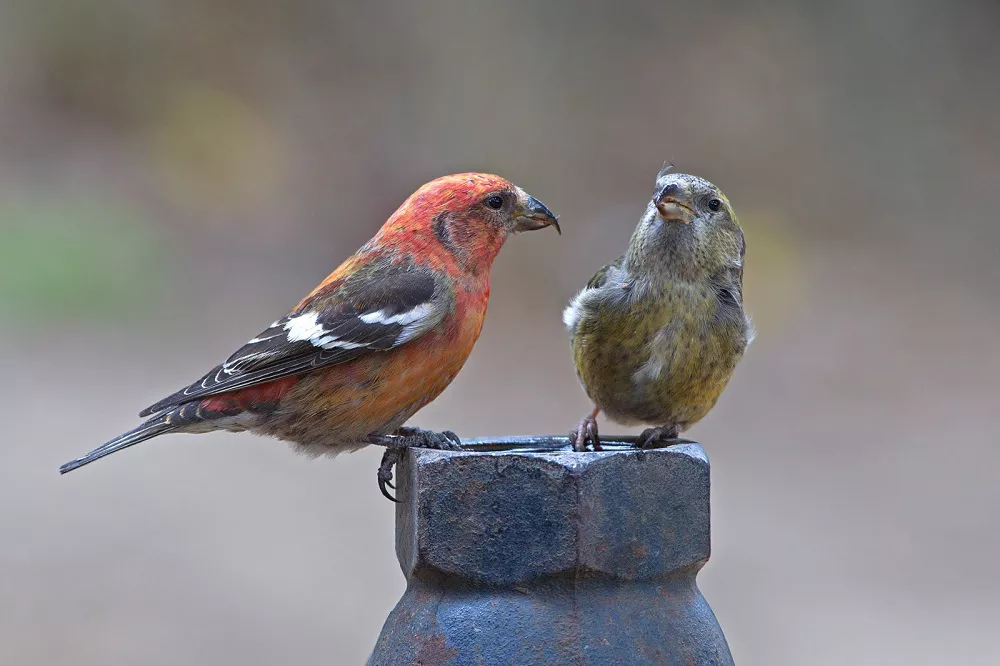The White-winged Crossbill (Loxia leucoptera) is a charismatic bird species that has adapted to thrive in the coniferous forests of North America and Eurasia. Known for its unique beak structure and specialized feeding habits, the White-winged Crossbill stands out among avian enthusiasts and researchers. In this article, we will explore the fascinating characteristics, habitat, behavior, and ecological significance of the White-winged Crossbill, shedding light on its remarkable adaptations and contributions to forest ecosystems.
Physical Characteristics:
The White-winged Crossbill is a medium-sized finch, measuring about 6 inches in length and weighing around 30 grams. One of its most distinctive features is its crossed bill, which is specially adapted for extracting seeds from conifer cones. Male White-winged Crossbills are typically brighter in color than females, with a reddish or orange hue on their heads, breasts, and backs and a contrasting white wing bar. Females and juveniles have a more subdued yellow-green coloration.
Habitat and Distribution:
White-winged Crossbills are found in boreal and montane coniferous forests across North America and Eurasia. They inhabit a range of coniferous trees, including spruce, pine, fir, and larch. Their distribution is often influenced by the abundance and availability of their primary food source, conifer seeds. They may also move long distances in search of suitable habitat and food.
Feeding Habits and Adaptations:
The White-winged Crossbill’s unique bill structure plays a crucial role in its feeding habits. The crossed bill allows it to pry open the scales of conifer cones and extract the seeds within. The tips of the bill may be either crossed to the right or left, enabling them to access seeds in cones that have evolved to open in the opposite direction. This specialized adaptation gives the White-winged Crossbill a distinct advantage in accessing an abundant and reliable food source.
Behavior and Social Structure:
White-winged Crossbills are highly gregarious birds, often observed in flocks. Their social structure is shaped by the availability of food resources, with larger flocks forming during periods of high seed abundance. They communicate using various calls and songs, which serve to maintain contact within the flock and coordinate feeding activities.
Breeding and Nesting:
The breeding season of White-winged Crossbills typically occurs between March and August, coinciding with the peak availability of conifer seeds. They construct cup-shaped nests in conifer trees, utilizing twigs, grass, and other plant materials. Females lay 2-4 eggs, which are incubated for about two weeks. Both parents take turns incubating the eggs and feeding the chicks once they hatch. The chicks fledge after about two weeks, but they continue to rely on their parents for food and protection for several weeks after leaving the nest.
Ecological Significance:
White-winged Crossbills play a crucial ecological role in coniferous forests. By extracting seeds from cones, they contribute to seed dispersal and facilitate forest regeneration. Their feeding habits also influence the structure and composition of forest communities by selectively foraging on specific conifer species. This behavior can influence the abundance and distribution of different tree species within the forest ecosystem.
Conservation Status and Threats:
The White-winged Crossbill is not currently considered globally threatened, but its population trends and local distributions can fluctuate due to the availability of conifer seeds. Habitat loss, degradation, and changes in forest management practices can impact their populations. Continued conservation efforts to protect and maintain healthy coniferous forests are essential for the long-term survival of this specialized feeder.
Conclusion:
The White-winged Crossbill is a fascinating bird species that has adapted its bill structure to exploit the resources of coniferous forests. Its unique feeding habits, vibrant plumage, and social behavior make it a captivating subject for bird enthusiasts and researchers alike. By studying and appreciating the White-winged Crossbill, we gain valuable insights into the intricate interplay between avian adaptations and forest ecosystems.


 Facebook
Facebook  Instagram
Instagram  Youtube
Youtube 